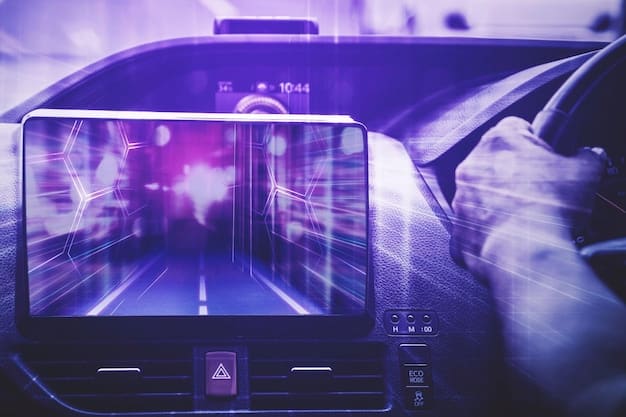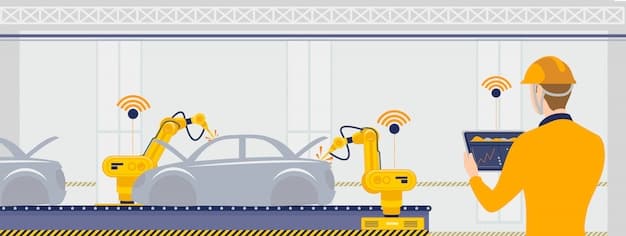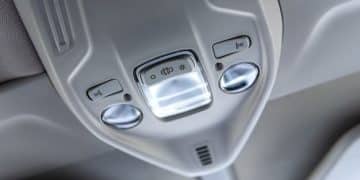Autonomous Driving: Regulatory Hurdles for US Manufacturers in 2025

Autonomous driving technology faces significant regulatory hurdles for US manufacturers in 2025, primarily concerning safety standards, data privacy, and liability frameworks, which require alignment between federal and state regulations to ensure safe and responsible deployment.
The path to widespread adoption of autonomous driving technology is paved with innovation, but US manufacturers in 2025 also face a complex web of regulatory hurdles. Understanding these challenges is critical for companies aiming to lead the future of transportation.
Autonomous Driving Technology: The Regulatory Landscape in 2025
As autonomous vehicles (AVs) advance, the regulatory environment is struggling to keep pace. For US manufacturers in 2025, a clear understanding of these regulations is crucial for navigating the complexities of bringing self-driving cars to market. This section explores the current state of regulations and their impact on the industry.
The development and deployment of autonomous driving technology in the United States are governed by a mix of federal and state regulations. At the federal level, the National Highway Traffic Safety Administration (NHTSA) plays a central role in setting safety standards and guidelines for motor vehicles, including AVs.

However, states also have considerable authority over vehicle operation within their borders, leading to a patchwork of different rules and requirements across the country.
Key Federal Regulations
Several federal regulations and guidelines shape the framework for autonomous vehicle development and testing in the US. These include:
- NHTSA’s Safety Standards: The NHTSA is responsible for establishing Federal Motor Vehicle Safety Standards (FMVSS) that apply to all vehicles sold in the United States. These standards cover a wide range of safety-related aspects.
- AV START Act (Potential): Although the AV START Act did not pass, it aimed to create a national framework for autonomous vehicles, potentially streamlining regulations and promoting innovation.
- Guidance Documents: Because legislation has been slow, NHTSA put forth guidance documents, which are not legally binding rules, but represent approaches that support safety without unduly inhibiting innovation.
State-Level Regulations
In addition to federal oversight, state governments play a significant role in regulating autonomous vehicles. Key areas of state regulation include:
- Permitting and Testing: Many states require manufacturers to obtain permits before testing autonomous vehicles on public roads. These permits often come with specific requirements, such as reporting data on safety.
- Licensing and Registration: States are responsible for determining how autonomous vehicles will be licensed and registered. This includes addressing issues such as who would be considered the “driver” of an AV.
- Liability and Insurance: States grapple with liability rules in the event of an accident involving an autonomous vehicle. Existing insurance frameworks may need to be updated to accommodate AVs.
The interplay between these federal guidelines and diverse state regulations presents a challenge for manufacturers seeking to deploy autonomous vehicles nationwide. Harmonization of regulations is essential to facilitate innovation and ensure a consistent safety standard across state lines.
Safety Standards and Certification
Ensuring the safety of autonomous vehicles is paramount, and this requires stringent safety standards and comprehensive certification processes. US manufacturers in 2025 must navigate evolving safety requirements to gain public trust and regulatory approval.
The NHTSA’s Federal Motor Vehicle Safety Standards (FMVSS) are the benchmark for vehicle safety in the United States. However, these standards were primarily designed for human-driven vehicles, posing challenges for their applicability to autonomous systems.

Modifications and new standards are needed to address the unique safety considerations of AVs.
Evolving Safety Standards
Several modifications and additions to existing safety standards are under consideration to accommodate autonomous vehicles:
- Redundancy and Fail-Safe Systems: Standards may require autonomous vehicles to have redundant systems that can take over in the event of a primary system failure.
- Cybersecurity: As AVs rely heavily on software and connectivity, cybersecurity standards are crucial to protect against hacking and malicious attacks.
- Software Validation: Standards may require manufacturers to provide robust validation and verification processes to ensure the reliability and safety of AV software.
Certification and Compliance
Compliance with safety standards is essential for manufacturers to sell their vehicles in the United States. The certification process for autonomous vehicles needs to be rigorous and transparent:
- Self-Certification vs. Third-Party Assessment: The current system relies on self-certification by manufacturers, but some argue for independent, third-party assessment to ensure objectivity.
- Data Logging and Reporting: Regulations may require AVs to log and report data on their performance, allowing regulators to monitor safety and identify potential issues.
- Recall Procedures: Clear procedures for recalling and repairing autonomous vehicles in the event of safety defects are necessary to protect the public.
Meeting evolving safety standards and undergoing thorough certification processes are critical steps for ensuring the safe and reliable deployment of autonomous vehicles. These measures help build public confidence and pave the way for regulatory acceptance.
Data Privacy and Security Concerns
Autonomous vehicles generate vast amounts of data, raising significant concerns about data privacy and security. US manufacturers in 2025 must address these issues proactively to protect consumer trust and comply with increasingly stringent regulations.
AVs rely on sensors, cameras, and other technologies to collect data about their surroundings and the behavior of their occupants. This data can include location information, driving habits, and even personal communications.
Data Collection and Usage
Regulations are needed to define how data collected by autonomous vehicles can be used and shared:
- Purpose Limitation: Regulations may restrict the use of data to specific purposes, such as improving vehicle safety or navigation, and prohibit using it for unrelated purposes like targeted advertising.
- Data Minimization: Manufacturers may be required to minimize the amount of data they collect to only what is strictly necessary for the operation of their vehicles.
- Transparency: Consumers need to be informed about what data is being collected, how it is being used, and with whom it is being shared.
Cybersecurity Measures
Protecting autonomous vehicles from cyber threats is paramount for safety and data security:
- **Secure Architecture:** AVs should be designed with a secure architecture that protects against unauthorized access and tampering.
- **Software Updates:** Regular security updates are necessary to patch vulnerabilities and defend against new threats.
- **Data Encryption:** Data transmitted to and from the vehicle should be encrypted to prevent eavesdropping and data breaches.
Addressing data privacy and security concerns is crucial for fostering public trust and ensuring the responsible deployment of autonomous vehicles. Regulations should strike a balance between protecting individual rights and fostering innovation.
Liability and Insurance Frameworks
Determining liability in the event of an accident involving an autonomous vehicle is a complex legal challenge. US manufacturers in 2025 must work with regulators and insurers to establish clear liability and insurance frameworks.
Traditional liability and insurance models are based on the concept of driver negligence. However, when a vehicle is operating autonomously, it is not always clear who is responsible for an accident.
Defining Liability
Several parties could potentially be held liable in an accident involving an AV:
- The Vehicle Owner: The owner of the vehicle may bear some responsibility, especially if they failed to properly maintain the vehicle.
- The Manufacturer: The manufacturer could be held liable if the accident was caused by a defect in the vehicle’s design or software.
- The Software Developer: The developer of the autonomous driving software could be held liable if the accident was caused by a software malfunction or error.
Addressing liability and insurance frameworks is essential for resolving legal issues and ensuring that victims of accidents involving autonomous vehicles receive fair compensation. These frameworks should be designed to promote innovation and accountability.
Ethical Considerations in Autonomous Driving
Autonomous vehicles raise complex ethical dilemmas that must be addressed through regulation and industry standards. US manufacturers in 2025 need to consider these ethical implications to ensure their technology is both safe and socially responsible.
One of the most prominent ethical challenges is the “trolley problem,” in which an AV must choose between two unavoidable courses of action, each with different consequences. For example, an AV may need to decide whether to swerve to avoid hitting a pedestrian, potentially endangering its occupants.
Ethical Guidelines
Developing ethical guidelines for autonomous vehicles is essential for addressing these dilemmas:
- Prioritizing Safety: Guidelines should prioritize the safety of all road users, including pedestrians, cyclists, and other drivers.
- Transparency: The decision-making processes of autonomous vehicles should be transparent and explainable.
- Accountability: Clear lines of accountability should be established for the ethical decisions made by autonomous vehicles.
Bias and Fairness
- **Data Diversity:** AV algorithms should be trained on diverse datasets to avoid perpetuating biases.
- **Mitigating Algorithmic Bias:** Developers should actively work to mitigate biases in AV algorithms.
- **Fair Outcomes:** AV systems should be designed to ensure fair outcomes for all road users, regardless of their demographics.
Addressing ethical considerations is crucial for building public trust and ensuring that autonomous vehicles are deployed in a responsible and socially beneficial manner. Manufacturers, regulators, and ethicists must work together to develop guidelines and standards that address these complex issues.
The Future of Autonomous Vehicle Regulation
The regulatory landscape for autonomous vehicles is constantly evolving, and US manufacturers in 2025 need to stay informed about emerging trends and potential changes. Collaboration between industry, government, and the public will be crucial for shaping the future of AV regulation.
One of the most important trends is the increasing focus on performance-based standards. Rather than prescribing specific technologies or designs, these standards set performance targets that autonomous vehicles must meet, allowing manufacturers greater flexibility in their approach.
Emerging Technologies and Regulations
Several emerging technologies are likely to shape the future of autonomous vehicle regulation:
- Artificial Intelligence (AI): As AI becomes more sophisticated, regulations may need to address the ethical implications of AI-driven decision-making in AVs.
- Connectivity and 5G: Regulations may need to address cybersecurity and data privacy issues related to connected and autonomous vehicles.
- Sensor Technology: As sensor technology advances, regulations may need to address the accuracy and reliability of sensors in various driving conditions.
Collaboration and Harmonization
- **Federal-State Collaboration:** Collaboration between federal and state governments is essential for creating a consistent and efficient regulatory framework.
- **Industry-Government Partnerships:** Partnerships between industry and government can help accelerate the development and deployment of safe and effective autonomous vehicle technologies.
- **International Harmonization:** Harmonizing regulations with other countries can facilitate international trade and promote innovation.
By staying informed about emerging trends and actively participating in the regulatory process, US manufacturers in 2025 can help shape a future in which autonomous vehicles are safe, reliable, and beneficial for society.
| Key Aspect | Brief Overview |
|---|---|
| 🚦 Regulations | Federal and state laws impacting AV testing and deployment. |
| 🛡️ Safety Standards | Ensuring AVs meet rigorous safety benchmarks. |
| 🔒 Data Privacy | Protecting user data collected by AVs. |
| ⚖️ Liability | Establishing who is responsible in case of AV accidents. |
Frequently Asked Questions (FAQ)
<
▼
The National Highway Traffic Safety Administration (NHTSA) is the main federal agency. It sets safety standards and issues guidelines helping autonomous vehicle development.
▼
State regulations vary widely. Some states require permits for testing AVs; others have less stringent requirements, leading to a diverse regulatory landscape.
▼
AVs bring ethical dilemmas, such as trolley problems. These require AVs to make choices with different outcomes, raising complex ethical considerations about safety.
▼
AV regulations seek to define data use, ensuring it enhances safety, and requires companies to minimize data collection. They protect against misuse for targeted purposes.
▼
Liability can fall on various entities, like vehicle owners, manufacturers, or software developers. Determining liability is crucial to compensate victims fairly.
Conclusion
Navigating the regulatory landscape for autonomous driving technology in the US in 2025 requires a multifaceted approach. Manufacturers must prioritize safety, data privacy, and ethical considerations while working with regulators to create clear and consistent frameworks that foster innovation and ensure public trust. Addressing these challenges proactively will pave the way for the responsible deployment of autonomous vehicles and unlock their potential to transform transportation.





